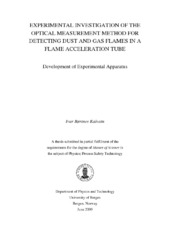Experimental Investigation of the Impedance Measurement Method for Detecting Dust and Gas Flames in a Flame Acceleration Tube. Development of Experimental Apparatus
Master thesis
Permanent lenke
https://hdl.handle.net/1956/3547Utgivelsesdato
2009-06-02Metadata
Vis full innførselSamlinger
Sammendrag
This thesis describes an experimental investigation of flame propagation in a 3.6-meter Flame Acceleration Tube (FAT) by the use of optical probes for flame detection and dust concentration measurements. The experiments in the FAT took place in the workshop of GexCon AS at Fantoft, Bergen. Fellow Master Student Gisle A. Enstad, who took part in the shared experiments, describes the impedance flame detection method in his thesis. Flame detection and dust concentration probes were made. Preliminary tests were performed at the University of Bergen in the 20-litre explosion vessel of the USBM type. The final design of the probes implements both the optical and impedance based measurement method. In the preliminary phase of this work, the FAT was equipped with instrumentation cables and power supplies for measurement probes and electrically operated valves. A complete logging system with cables, a logging card from National Instruments and software for running the experiments was also set up as a part of this project. Closed vessel experiments were performed with both maize starch and propane/air mixtures in the FAT. As the FAT was fitted with six circular windows at one side, the experiments could be recorder with a high-speed camera. A general trend in the results from the experiments was that the optical method detected the flame earlier than the impedance method. Video observations tended to measure the flame arrival time earlier than the optical method on gas and later on dust, while the impedance method were later than the other two. A thermocouple was also used as a reference to the other methods and it showed good correlation with the optical/impedance probe, as it measured the flame arrival time between the times measured by the two other principles.
Utgiver
The University of BergenOpphavsrett
The authorCopyright the author. All rights reserved
